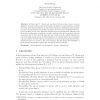Free Online Productivity Tools
i2Speak
i2Symbol
i2OCR
iTex2Img
iWeb2Print
iWeb2Shot
i2Type
iPdf2Split
iPdf2Merge
i2Bopomofo
i2Arabic
i2Style
i2Image
i2PDF
iLatex2Rtf
Sci2ools
104
click to vote
INDOCRYPT
2003
Springer
2003
Springer
Security Analysis of Several Group Signature Schemes
At Eurocrypt’91, Chaum and van Heyst introduced the concept of group signature. In such a scheme, each group member is allowed to sign messages on behalf of a group anonymously. However, in case of later disputes, a designated group manager can open a group signature and identify the signer. In recent years, researchers have proposed a number of new group signature schemes and improvements with different levels of security. In this paper, we present a security analysis of five group signature schemes proposed in [25, 27, 18, 30, 10]. By using the same method, we successfully identify several universally forging attacks on these schemes. In our attacks, anyone (not necessarily a group member) can forge valid group signatures on any messages such that the forged signatures cannot be opened by the group manager. We also discuss the linkability of these schemes, and further explain why and how we find the attacks.
Related Content
| Added | 07 Jul 2010 |
| Updated | 07 Jul 2010 |
| Type | Conference |
| Year | 2003 |
| Where | INDOCRYPT |
| Authors | Guilin Wang |
Comments (0)

